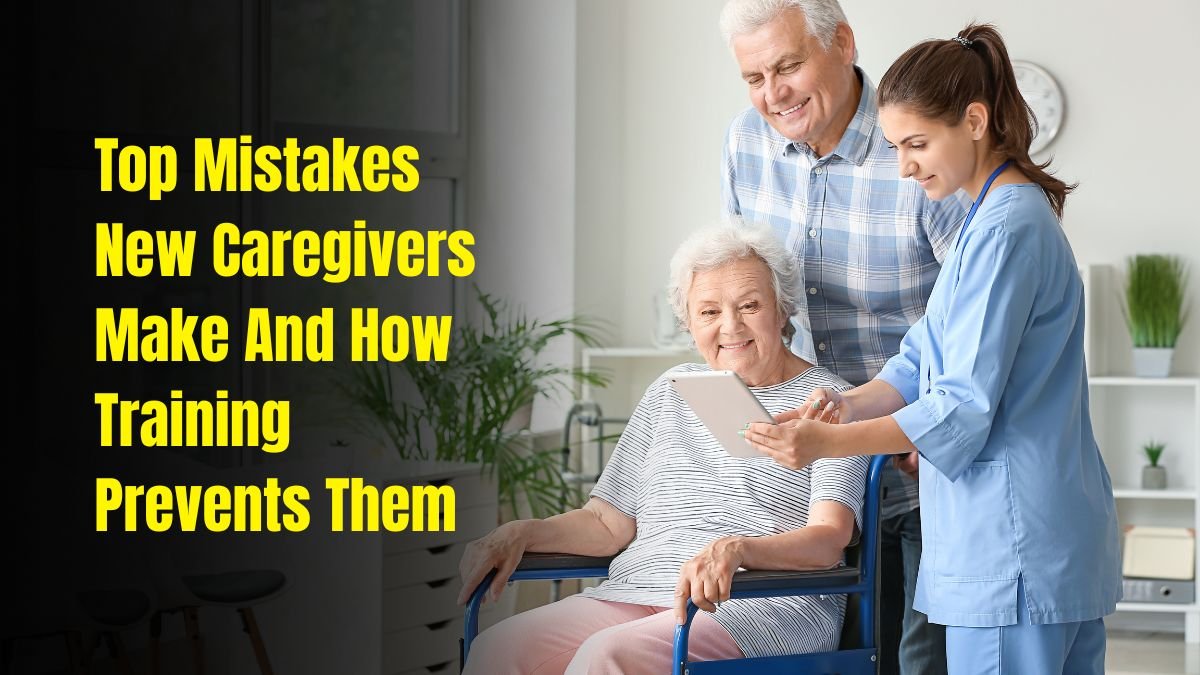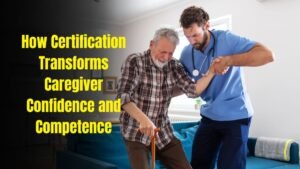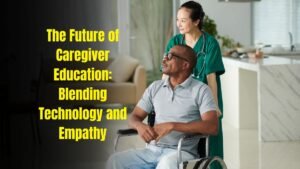Stepping into the role of a caregiver—whether for an aging parent, an ill spouse, or a disabled loved one—is an act of compassion that demands both heart and skill.
Yet, despite their best intentions, new caregivers often make mistakes that can compromise patient safety, increase stress, and lead to burnout.
The caregiving field, both professional and informal, has one of the highest turnover rates in healthcare, largely due to insufficient preparation and emotional strain.
Recent studies show that over 70% of new caregivers in North America report feeling overwhelmed during their first year, while only 1 in 10 receive structured training before assuming caregiving duties.
This lack of training contributes to a wide range of preventable mistakes—from medication errors to communication breakdowns.
This article dives deep into the most common caregiver mistakes and highlights how comprehensive training programs can transform caregiving from a stressful experience into a confident and compassionate profession.
Why New Caregivers Make Mistakes
Most caregivers start with empathy—but not with expertise. Family caregivers, especially, are thrust into demanding roles after a medical emergency or a sudden diagnosis.
Without adequate education, they must navigate complex tasks such as administering medication, managing medical devices, maintaining hygiene, and offering emotional support—all at once.
Common reasons caregivers make errors include:
- Insufficient training and guidance in basic care procedures.
- Stress and emotional exhaustion, leading to poor judgment.
- Multitasking fatigue, where juggling multiple responsibilities reduces focus.
- Lack of clear communication with healthcare providers or family members.
- Poor organization and documentation, resulting in missed medications or conflicting schedules.
Caregiver mistakes are rarely intentional—they stem from inexperience and lack of support. That’s why structured training programs, even short courses, can dramatically reduce these risks and improve quality of care.
Common Mistakes New Caregivers Make
| Mistake | Impact on Caregiver / Patient | How Training Prevents It |
|---|---|---|
| Medication errors | Wrong dosage or missed doses | Teaches proper medication handling and monitoring |
| Poor communication | Conflicts, misinterpretations, stress | Builds active listening and reporting skills |
| Ignoring self-care | Fatigue, illness, burnout | Promotes balance and resilience |
| Lack of safety awareness | Falls, injuries, accidents | Provides home safety and fall prevention skills |
| No crisis plan | Panic in emergencies | Prepares caregivers for real-time decision-making |
| Taking on too much (“job creep”) | Overwork and errors | Defines clear professional boundaries |
| No documentation | Confusion or loss of medical data | Trains on accurate record-keeping |
| Overlooking abuse or neglect | Risk to patient’s well-being | Teaches early recognition and reporting methods |
Detailed Breakdown: Key Mistakes and Solutions
1. Medication Mismanagement
This is among the most frequent and dangerous caregiver mistakes. Forgetting a dose, double-dosing, or misreading prescriptions can have serious medical consequences.
Training programs include medication management modules that teach dosage accuracy, label reading, scheduling, and side effect monitoring. Many also introduce digital tools and apps to automate reminders and track adherence.
2. Communication Gaps
New caregivers sometimes feel intimidated when interacting with doctors or family members. Miscommunication can result in repeated tests, missed appointments, or inconsistent instructions.
Training teaches caregivers how to document patient updates, ask clarifying questions, and report changes effectively, ensuring everyone in the care circle stays informed.
3. Ignoring Self-Care
A burned-out caregiver cannot provide quality care. Many new caregivers overlook their own health—leading to fatigue, frustration, and even depression.
Training emphasizes self-care routines, rest cycles, and recognizing the signs of burnout early. Studies show that trained caregivers report 35% less stress and 50% fewer sick days than those without education.
4. Failure to Create a Care Plan
Without a structured care plan, caregivers often operate reactively instead of proactively. Training teaches how to organize daily routines, manage time efficiently, and prepare for emergencies. A proper care plan includes schedules for medication, meals, hygiene, rest, and physical activity—all key to patient stability.
5. Safety Oversight
The home environment is full of hidden hazards—uneven floors, poor lighting, slippery bathrooms, or unsecured furniture. A lack of safety awareness increases the likelihood of accidents.
Certified training includes home safety audits and ergonomic transfer techniques, which help prevent falls and injuries.
The Role of Training in Professionalizing Caregiving
Training transforms caregiving from an emotionally driven activity into a professional skill. Programs offered by healthcare organizations, community colleges, and agencies provide structured learning on:
- Patient hygiene and infection control
- CPR and first aid
- Mobility and transfer assistance
- Nutrition and meal planning
- Mental health awareness
- End-of-life care and communication
Many of these courses can be completed in 20–40 hours, yet their benefits last a lifetime. They not only protect patients but also reduce caregiver turnover, which is a growing issue in healthcare.
According to the U.S. Bureau of Labor Statistics, the demand for trained caregivers is expected to rise by 25% by 2032, making training both a professional necessity and a personal safeguard.
Data on Caregiver Training Impact
| Category | Without Training | With Training |
|---|---|---|
| Average medication error rate | 1 in 5 caregivers | 1 in 20 caregivers |
| Caregiver burnout rate | 61% | 33% |
| Hospital readmission within 30 days | 28% | 17% |
| Reported patient satisfaction | 65% | 90% |
| Caregiver retention (1 year) | 58% | 81% |
These figures highlight how even short-term caregiver education dramatically improves both patient safety and caregiver wellbeing.
Soft Skills Training: The Hidden Advantage
Beyond medical procedures, training also enhances emotional intelligence and communication—skills that define truly great caregivers.
Modules on active listening, empathy, conflict management, and stress control help caregivers maintain professionalism even in emotionally charged situations.
Soft skills training ensures caregivers can connect compassionately while maintaining healthy boundaries, reducing the risk of emotional fatigue.
In addition, these interpersonal skills improve the overall patient experience, which contributes to faster recovery and higher satisfaction.
The Financial and Emotional Benefits of Training
Investing in caregiver training saves both money and heartache. Families supported by trained caregivers spend 20–25% less on avoidable hospitalizations or medical complications.
On an emotional level, training reduces guilt and anxiety, helping caregivers feel capable and appreciated rather than helpless and overwhelmed.
Furthermore, organizations employing trained caregivers face lower turnover rates, improved efficiency, and better compliance with healthcare standards.
Training ensures everyone benefits—from the care recipient to the healthcare system itself.
Government and Institutional Efforts to Improve Caregiver Education
Recognizing the importance of caregiver training, many governments are implementing reforms to expand access to education. For example:
- In the United States, caregiver education grants and subsidies have been introduced under the National Family Caregiver Support Program (NFCSP).
- In Canada, provinces are launching online and in-person caregiver certification initiatives through health authorities and community agencies.
- In the UK, organizations like Skills for Care offer free learning modules to strengthen the national care workforce.
These initiatives demonstrate a growing global recognition that training is essential for quality, safety, and sustainability in caregiving.
Future of Caregiver Training
With AI, virtual reality, and simulation-based education entering the caregiving field, the next generation of caregivers will learn through realistic scenarios and interactive technology.
These advancements allow trainees to practice decision-making in safe, controlled environments before handling real patients.
Training will also become more personalized, using analytics to identify weaknesses and tailor learning experiences.
As technology evolves, caregivers will continue to gain better skills, confidence, and resilience, creating a more prepared workforce worldwide.
The role of a caregiver is one of the most compassionate yet challenging positions in society. Without proper preparation, even the most dedicated individuals can make mistakes that affect health outcomes, emotional wellbeing, and safety.
However, training empowers caregivers—equipping them with the skills, confidence, and resilience to perform their duties effectively.
Comprehensive training reduces medical errors, improves communication, and protects both patients and caregivers from preventable harm.
As populations age and caregiving demands rise, the future of healthcare will depend on trained, informed, and empathetic caregivers who treat their role not as a burden, but as a profession of purpose and pride.
FAQs
How long does it take to complete caregiver training?
Most basic caregiver training programs take between 20 and 40 hours, though advanced certifications in dementia, palliative care, or medical assistance can take several weeks.
Can family caregivers take the same training as professionals?
Yes. Many institutions encourage family caregivers to join professional courses, as they teach practical skills needed for home care, patient safety, and emotional resilience.
How can training reduce burnout and stress?
By teaching time management, emotional coping, and self-care strategies, training helps caregivers balance responsibilities and avoid exhaustion, leading to better overall health.




